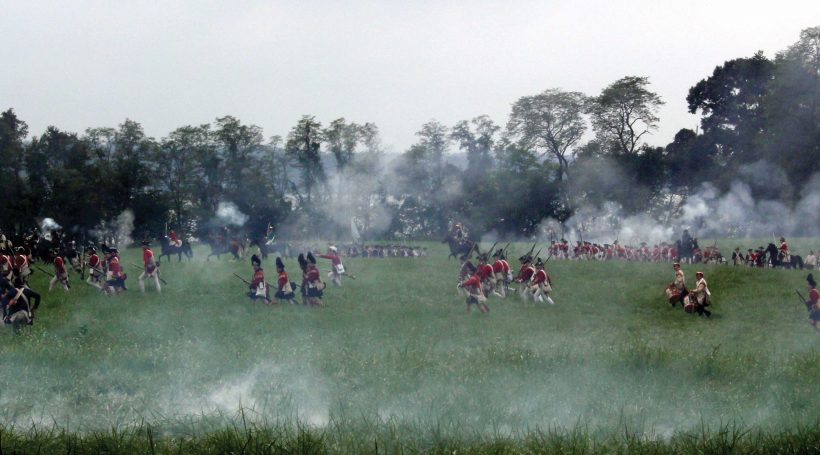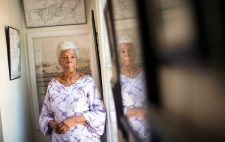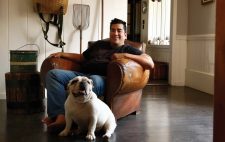On some mornings, Mount Holly’s Paul Loane puts on a long, blue wool coat and grabs his rifle. He heads out to join his fellow militia men on the battlefield, where shots are fired, cannons blast and men fall down and play dead. It’s these days when Loane gets a glimpse of life from long ago. Sometimes the glimpse is so real, it’s like he’s been transported back in time.
“We call it the magic moment. It’s hard to describe, but it is a feeling that comes over you for just seconds,” says Loane, who heads two war reenactment troops. “It’s that moment you realize where you are, what you are doing or what is surrounding you is exactly what it was back then. I’ve had several, but it doesn’t happen every year.”
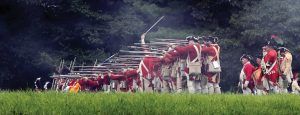 Finding your magic moment means you and your fellow soldiers have taken authenticity to a new level. You’re wearing the right clothes, using the proper weapons and fighting at a location identical to those from hundreds of years ago. Loane and his group – the Second Pennsylvania Regiment and the 43rd Regiment of Foot – go to great lengths to accurately portray every aspect of the battles of the Revolutionary War, including its soldiers, both British (43rd Regiment) and American (Second PA Regiment).
Finding your magic moment means you and your fellow soldiers have taken authenticity to a new level. You’re wearing the right clothes, using the proper weapons and fighting at a location identical to those from hundreds of years ago. Loane and his group – the Second Pennsylvania Regiment and the 43rd Regiment of Foot – go to great lengths to accurately portray every aspect of the battles of the Revolutionary War, including its soldiers, both British (43rd Regiment) and American (Second PA Regiment).
“We want to be able to conduct ourselves the way they conducted themselves, and fight the way they fought using the tactics and drills they did,” Loane says. “We are an educational organization; you can look at our regiment as a large, colorful and unusual classroom.”
Their classroom lesson comes to life – literally – at the group’s living history demonstrations. Held mostly on weekends, these programs don’t include battle reenactments, but do allow the public to mingle with the reenactors, asking questions or simply hearing about life during the Revolutionary War.
“We set up a small camp with a few tents. Our camp followers – people portraying the women and children who travelled with the soldiers – will prepare food in an 18th-century manner,” Loane says. “We’ll do narrated firing demonstrations where I talk about the uniforms, the gear, why the men fought that way and what their lives were like. Then the men demonstrate firing volleys, bayonet charges, advancing and other tactics.”
In battle reenactments, there is less audience interaction. Typically, attendees watch the action from the perimeter of the field.
“Most of our Revolutionary War reenactments are scripted,” Loane says. “Weeks before the event the commanders of each army meet to look over the terrain and decide how to best use the land. Where is the best place to put the artillery? Where should the main battle take place? Are there woods through which troops can maneuver?”
The recreated battlefield includes a camp with tents, cooks and even sutlers. “Sutlers are merchants and craftsmen selling reproduction 18th-century military goods, like cartridge boxes and bayonets, for reenactors to use,” says Loane.
Another reenacting group, the 12th New Jersey Volunteer, Company K, demonstrates Civil War battles. Unlike Loane, who is limited by the lack of photos and writings from the Revolutionary War, the 12th Infantry has more historical materials available from the Civil War. Captain Rich Mendoza uses authentic drill manuals to get every march right, and he follows historic battle plans to stage battles.
Although the guns used at the reenactments are usually authentic, the ammunition is not. Instead of bullets, reenactors fire blank rounds of black powder, which was used in both wars.
But without bullets, how do the men know when to tumble to the ground? That’s the job of the captain. “Casualties in reenactments are determined by whatever the scenario calls for,” Loane says. “If you’re on the side that is supposed to lose, then you can expect to be told to fall on the ground at the appropriate time or perhaps run from the field.”
Sometimes, a soldier may simply choose to fall to the ground. “They might think, ‘Well, I’m done,’ or they might run out of ammo,” Mendoza says.
Mendoza is glad his days of taking hits, running and diving are over. As captain, he gets to send his army out in front and leave most of the fighting to the privates. Although he’s not guaranteed to survive every battle, he says his job is pretty easy.
“I have a lieutenant, then a sergeant, then a corporal, and everyone else is a private,” Mendoza says. “I just tell the lieutenant what to do. He turns around and tells the sergeant who tells the corporals, and the privates do all the work.”
Reenacting is an expensive hobby, especially when you strive for authenticity. “You need the coat which is $70, the pants are the same and a hat,” Mendoza explains. “And we don’t want people to buy junk, so we direct them on exactly what to buy. Luckily, there are a lot of photographs from the 12th NJ Infantry, so we use them to see what uniforms we should be wearing.”
The rifle is the most important piece of the uniform, as well as the most expensive, Mendoza says. Costing just under $1,000 today, this item was once each soldier’s lifeline while fighting, and reenactors treat it the same way.
“We have an armorer who looks at them from a professional standpoint. He knows if your gun is in good shape, or he’ll tell you if it’s not,” Mendoza says. “We clean our rifles regularly, except for the handful of people who just stick it in the closet and think it’s gonna clean itself. Then they have to spend more money to get it back in shape.”
For dedicated reenactors, this hobby can become an around-the-clock commitment, but not every task on battle day involves fighting. There’s plenty of time for socializing.
“Everyone stays in their 18th-century clothes,” says William McIlhenny, president of the West Jersey Artillery. “They’ll go to soirees and other social events, sit around, have something to drink and talk to people.”
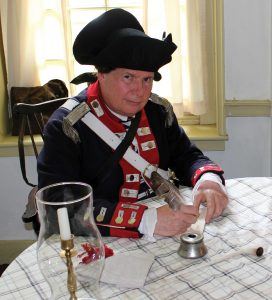
Paul Loane commands the Second Pennsylvania Regiment from Haddonfield’s Indian King Tavern
If you think joining the reenactors is something you’d enjoy, Loane suggests watching historical movies or reading books to ease into the hobby. “You must have an interest in history, but it could be very low, which may mean you only look at the history channel a couple times a week,” he says. “Then it kind of follows. You get involved, you learn, and your interest is heightened.”
McIlhenny’s interest is so great it’s landed him a few jobs in Hollywood. Filmmakers looking to make their historic movie accurate rely on him for guidance.
“I was filming for about four-and-a-half weeks on ‘The Patriot,’ and I remember a week in, people were whining and complaining about the lack of authenticity,” he says. “The director stood up and said, ‘We are making an entertaining film, not a documentary. You can leave if you want to.’ The movies are a good stepping stone, but they’re not necessarily documentaries.”
Mendoza has also worked on movies, including the 1989 film “Glory.” Although, it wasn’t until he was asked to join the production of “The Last of the Mohicans,” a film featuring French and British fighters, that he realized how historical knowledge could be misused.
“I said, ‘Well, I have knowledge of the Civil War, not the French and Indian War,’ and the guy said, ‘Well, they carried guns, right?’” Mendoza explains. “I had to unlearn the Civil War tactics and relearn the tactics of the French and British in the 1700s. The movie-people mentality is not always up to what it should be.”
Whether it’s for movies or just for fun, these men and women dedicate much time to reenacting, and that passion doesn’t disappear. “When I decide to retire, I’m not quitting the regiment, just turning in my captain’s hat,” Mendoza says. “The next guy will take over and be in charge, and we’ll keep the regiment going.”

